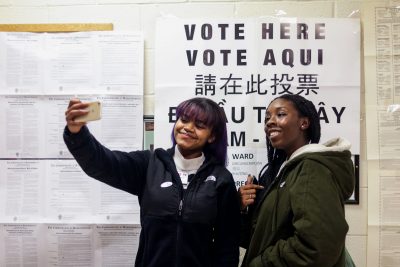
Regardless of which party is in control of Congress after midterm elections Tuesday, one result is inevitable: the onslaught of selfies with the “I Voted” sticker that cover Facebook, Instagram and Snapchat.
Within the last 24 hours, the likes of Zendaya, Oprah Winfrey, Reese Witherspoon and John Krasinski have posted on Instagram with “I voted” stickers, shirts and ballots.
In the 2014 midterm elections, only 23 percent of voters ages 18 to 34 voted, according to the U.S. Census. Early and absentee voting has shown a significant uptick in young voters in contested races.
Peter Blake, a professor in the Psychological and Brain Sciences Department at Boston University, said “I voted” sticker selfies that younger voters post online after heading to the polls may be done to appear a certain way.
“We have reputations that we want to maintain, but in a way, if that gets you to the polls — OK,” Blake said.
Blake said that he does not see the “I voted” selfie as entirely about boosting social capital, however.
“Another more positive way to look at it is that you’re saying, in a genuine way, I’m the kind of person who votes,” he said. “Identifying yourself as a participant, as a member of civic society — that identification has been shown to elevate people’s willingness to register to vote.”
The exact date the stickers were introduced to the polls is unknown, but according to Time Magazine, the earliest mention of them was in a Miami Herald article in 1982. Phoenix Realtors Association and National Campaign Supply began distributing and selling the stickers in 1985 and 1986.
Blake mentioned a study conducted in 2012 that involved 61 million Facebook users. One group of users was given a message that emphasized that many of their friends voted. Another group was given information about voting but was not told anything about whether their friends voted.
“There was a small effect of more people going to the polls, but it was only around 24,000 people out of the 61 million,” Blake said.
Despite these marginal results, he said that he is still optimistic about social media’s ability to increase voter turnout because the study was only conducted on the day of voting.
“You can try to establish a social norm by sending these signals through social media that you voted,” Blake said. “The benefit now is that in many states you can do early voting. It’s not just the day of, it’s the week before that you start seeing all the people you know change their profile pics to ‘I voted.’”
Jill Lepore, David Woods Kemper ’41 Professor of American History at Harvard University, explained that times have changed from when voting was entirely open. She said that until the presidential election of 1896, individuals who voted in secret were considered cowardly.
“Election day was a holiday, and it involved a lot of drinking and partying at the polls, and turnout was extremely high,” Lepore said.
The advent of the secret ballot not only made a person’s vote private, but it made the act itself private, since voting was then conducted indoors instead of outside, Lepore said.
“Turnout has been falling ever since,” she said.
Lepore said some have argued for online voting in an effort to increase turnout by making voting easier, but she feels dubious about this proposition.
“History would suggest that fewer people will vote if there’s online voting,” Lepore said. “What’s left of the public nature is that you go to your neighborhood elementary school and buy donuts and coffee from the fourth grade class, your hanging out and talking to people in line is some piece of civic experience … with online voting, this would be lost.”
Blake emphasized the effect of strong civic norms on voter turnout.
“It established that this is a common, positive norm, and that’s what I think will make more of a difference in encouraging people to vote,” Blake said.
Hallie Kruh-Needleman, a junior in the College of Arts and Sciences, said she advocates for the sticker selfie and that she and her mom take those photos themselves. She said she sees the “I voted” selfie as a way to express civic participation and democratic pride.
“People who post selfies with the ‘I voted’ sticker show that we live in a democracy, we have the right to vote, and people like to express that right and tell other people they have that right too,” she said.



























































































































